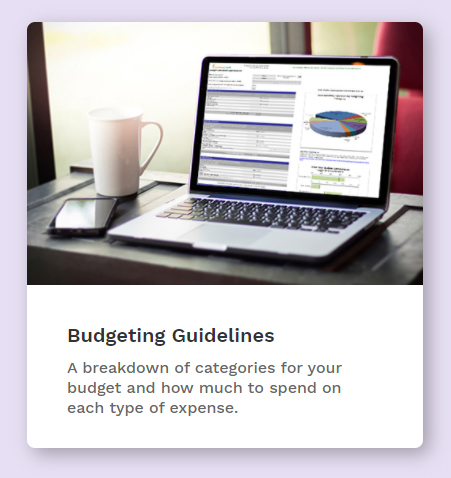How to Set Financial Goals in the New Year
By Debra Pangestu
 Getting our finances in order is a common New Year’s resolution, and one of the best things you can do to achieve this is to know how to set financial goals. Setting financial goals – whether they’re short-term or long-term, big or small – puts you in charge of your money, and your life. Financial goals also give you a sense of purpose, make you accountable, and give you momentum to continue on your quest towards financial freedom.
Getting our finances in order is a common New Year’s resolution, and one of the best things you can do to achieve this is to know how to set financial goals. Setting financial goals – whether they’re short-term or long-term, big or small – puts you in charge of your money, and your life. Financial goals also give you a sense of purpose, make you accountable, and give you momentum to continue on your quest towards financial freedom.
If you’ve set financial goals in the past but didn’t have much luck achieving them, it’s time to try a SMART approach to goal setting. By applying the SMART acronym, you’ll be able to set, monitor, and achieve your financial goals, guaranteed.
What are SMART Financial Goals?
They key to making financial goals is to ensure they’re geared towards a certain objective that has meaning to you, with clear steps and an estimation of when you’ll be able to achieve them. If your goals are vague with no “end date” in sight, you won’t know what you’re aiming for, which may make you less motivated to achieve your goals.
And, that’s where SMART goals come into play. To make your financial goals SMART, they need to follow the following criteria: Specific, Measurable, Attainable, Relevant, and Time-bound.
Before we start applying the SMART acronym, we first need to determine what goal we want to achieve. For this example, let’s say our goal is to pay off our credit card debt. It’s a fairly common goal, and yet many of us have a hard time achieving it. Here are the steps you should take in order to turn this financial goal into a SMART goal.
Make Your Financial Goal Specific
When it comes to goal setting, we often describe our goals in generic or vague terms. But for a goal to work, it needs to be specific and clearly defined so that you have something concrete to go after. Broad goals often don’t work because they’re open to interpretation, which can cause us to aim for several goals at once. Although there certainly isn’t anything wrong with having more than one goal, juggling several goals can make it difficult to stay on track, causing you to give up out of mere frustration.
To prevent this from happening, be as specific with your goal as you can. “Pay off credit card debt” is a goal, but we may have several credit cards with different banks and stores, which makes it difficult to tackle all at once. So, break down your goal and specify what credit card and which balance you want to pay off.
“Pay off credit card debt” is a generic goal, but “Pay off the $5,000 balance on my President’s Choice MasterCard” is a good smart goals example. By being specific, you’ll know exactly what you want to achieve so you’ll be in a better position to devise a plan and determine how much – and how long — you can commit to meeting your goal.
Make Your Financial Goals Measurable
Another feature of an effective financial goal is whether you’ll be able to measure your progress. For example, “Pay off the $5,000 balance on my President’s Choice MasterCard,” is a more effective goal than “Pay off my credit card debt” because you’ll also be able to measure how much debt you’ve paid off, and how much you still need to tackle.
In the case of our credit card example, having a concrete number – $5,000 – allows us to project how much we can afford to pay and what the remaining balance should be at the end of each month. Having a measurable goal keeps us on track, helps us see how far we’ve come, and gives us the motivation to keep on going.
To make a goal measurable, you need to get clear on what you want to achieve, and if you can, try to attach a numeric value to your goal, whether it’s a dollar amount or a time frame. Without a way to measure your goal, you won’t have a way to track your progress, and you won’t be able to determine whether your goal is attainable, which we’ll discuss below.
Set Attainable Financial Goals
It’s one thing to set financial goals, but it’s another thing to know how to set financial goals that are within your reach. Although we are certainly capable of accomplishing great feats if we put our mind to it, there are some limitations and external factors we should take into account before setting ambitious goals.
A common mistake with setting financial goals is that we often set lofty goals we can’t reasonably achieve. A good goal should challenge us but it shouldn’t be far-fetched, otherwise it’ll only be a matter of time before we get frustrated and give up on our goals altogether.
To ensure your goals are attainable, it’s important that you take some precautionary measures. For example, “Pay off the $5,000 balance on my President’s Choice MasterCard” sounds like an attainable goal, but what happens if that balance goes up? Will you still be able to clear that credit card balance if it balloons up to $7,500? Likewise, if you were to encounter a job layoff, a medical emergency or expensive home repairs, would you still be able to see your goals through?
Ask yourself these questions and set up some safety measures, like saving money and freezing your credit card. If you put a temporary hold on your card, you won’t be tempted to spend money and it ensures that your balance won’t go up. And, if you’ve explored different ways to save money, and have put in place a savings program that will work for your situation, you won’t have to backtrack on your goals when a financial emergency strikes because you’ll have some money on hand to deal with it. Here’s a list of some great money saving tips to help you find some ways to save.
Related: How to Save Money: Strategies for Saving in Canada
Ensure Your Financial Goals are Realistic
 Another key to successful financial goal setting is ensuring your goals are realistic. Continuing on with our example of paying off a $5,000 credit card debt, to make sure this a goal you can successfully see through, you need to make sure you set reasonable monthly debt payments you can keep up with. If money is tight and you have other debts to keep on top of, setting a goal to pay $50 a month may be more realistic than paying $100 a month.
Another key to successful financial goal setting is ensuring your goals are realistic. Continuing on with our example of paying off a $5,000 credit card debt, to make sure this a goal you can successfully see through, you need to make sure you set reasonable monthly debt payments you can keep up with. If money is tight and you have other debts to keep on top of, setting a goal to pay $50 a month may be more realistic than paying $100 a month.
To ensure you’re setting realistic targets for yourself, you can use one of these financial calculators to help you determine how much money you can afford to set aside, whether it’s for emergency savings or debt repayment.
Setting a realistic goal can be a balancing act. You don’t want to make your goal out of reach, but at the same time, you also don’t want to make your goal too small, otherwise you won’t get anywhere. If your goal is a bit of a challenge for you, you’ll also feel a real sense of accomplishment when you achieve it.
If your goals seem slightly out of reach in relation to your current financial situation, you’re better off scaling those goals back a bit so they’re more in line with your resources, and your time. Set goals you have the ability to achieve, but don’t be afraid to dream big.
Set Time-Bound Financial Goals
When you assign an end-date to any goal or task, it suddenly makes the goal more “real,” and it also gives you a timeframe with which you can focus on. Once you have a deadline, you have something to work towards, and you also have something to get excited about accomplishing! If we don’t set any deadlines for our financial goals, it becomes easy for our goals to get pushed back by other stuff that comes up, and ultimately, those goals may never end up getting done.
To create a time-bound goal, all you have to do is add an element of “when,” or an expiration date. For instance, “I want to save $2,000 for a trip to Spain over the next 18 months” is a more specific, measurable and time-bound goal than “I want to save for a vacation to Europe.” So in our credit card debt example, apply the same principle and transform your goal into, “Pay off the $5,000 balance on my President’s Choice MasterCard within 24 months.”
Having a “finish point” can play an important part in developing a successful financial goal. A timeframe allows you to measure your progress, it keeps you accountable to your intentions, and it also encourages you to keep taking the steps you need so you can get from where you are now, to where you want to be.
Start the New Year Afresh with Fresh Financial Goals
Many of us start the New Year with new financial goals, and to ensure you’re setting yourself up for success, this year make it a point to transform your goals into SMART goals. Whether your financial goal is paying off your debt, saving an emergency fund, or having enough money to go away on vacation, framing your goal so that it’s specific, measurable, attainable, realistic and time-bound will likely help you stay more focused and more motivated to see those goals through to completion.
Although we set goals for our personal and professional life, we often neglect to set goals for our finances, and this can sometimes give rise to financial troubles. Setting a financial goal is almost like setting a roadmap for your money, in that it shows you where you want to go, and it can help you make financially sound choices so you can reach your destination.
If you’re unsure of how to set SMART goals or your financial situation seems overwhelming, you can make an appointment to meet with one of our accredited, non-profit credit counsellors. In addition to helping you put together a budget, identifying all your financial options, and providing you with financial planning tools, they can also advise you in how to set financial goals.
Last Updated on January 26, 2025






The new year is the perfect time to set fresh financial goals. With the right strategies, consistency, and tracking, you can achieve your dreams. Start now to secure a brighter future ahead!